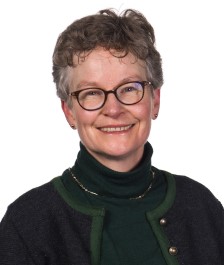
Nancy Black PhD, CCPE, PEng
Published: September 20, 2022
Current Position(s)
- Interim Vice-Dean and Professor at Université de Moncton in the Faculty of Engineering, Department of Mechanical Engineering
- Professional Engineer (P.Eng. registered in NB with the APEGNB)
- CCPE certified ergonomist (since 2021).
How long have you been an ACE member?
I joined ACE as a student member in 1993, when I was doing my Master’s degree (M.A.Sc. Industrial Engineering under the direction of Dr. Biman Das at the Technical University of Nova Scotia – now part of Dalhousie University). I maintained my student membership throughout my Ph.D. studies (at University of New Brunswick under the direction of Professor Jeremy Rickards and Dr. Edmund N Biden – in Mechanical Engineering). I became a “full member” in 2002, once I was no longer eligible to take advantage of the excellent cost reductions offered to students!
How did you first become interested in ergonomics?
When I was an undergraduate student of Systems Design Engineering at University of Waterloo in the 1980’s, I thought I’d want to do “biomedical engineering”. In my first year, I was introduced to “ergonomics” in one of the last classes taught by Dr. Thomas Morris Fraser; this science of ‘human systems’ was completely new to me but was interesting and “fun”. Thereafter, Professor Kish Hahn introduced our class to more ergonomics – human factors and health and safety via his passion for circadian rhythms and how they affect elite athlete performance when changing time-zones. I particularly liked the mix of physical and cognitive performance factors within the productivity context. I took every undergraduate course in this field available within my program – one in Human Machine Interfaces. One of our undergraduate design projects created the communications system for a way-finding dirigible balloon for assisting search and rescue operations in forested areas in Ontario. I loved the physical – perceptual – cognitive design aspects within the constraints of the real world.
Unfortunately, I was unable to do my final year project focussing on human factors directly. I studied ventilation systems to limit tobacco smoke in bingo parlours, back in the day when indoor smoking was common! And got the prize for the highest level of “bogosity” in my class!
What didn’t you learn in school that you wish you had?
I wish I learned more about the complexity of politics in companies (ex. fear of research participants liking new dynamic work environments tested can mean HR people don’t want to allow their employee colleagues to participate in research projects which introduce such environments temporarily). This is an ongoing challenge to the understanding of ergonomics and human factors as savings-centred rather than cost-centred.
I wish I had understood that sales staff (brochures) paint a prettier picture of their products abilities than reality allows. As a student and professor, I have encountered numerous measurement technologies that look PERFECT in advance, but lots of hiccups arrive during usage. One must be ready to adjust, adapt and create new solutions when doing research and practicing in REAL work environments.
What is your favourite aspect of being an ergonomist? What is your favourite aspect of being involved in ergonomics?
I love the large perspective associated with ergonomics / human factors.
I love the community of people that believe and focus on making work (“work” in the large sense – things we spend significant periods of time doing, or things we must do) better for the people doing it. I love the constant challenge to suppositions (underlying beliefs).
I love the fundamental respect one must consistently maintain for the persons doing the work.
I love to support improving health and productivity for my fellow humans given the technical constraints of the tools my engineering colleagues design.
I love sensitizing my engineering profession students and colleagues to ways that ergonomics and human factors complement the basic engineering sciences of largely inert materials.
What do you see as the biggest opportunity for ergonomists in the future?
Ergonomists and human factors (E/HF) specialists should (and must) become part of the design team at all levels. E/HF through Health and safety is coming to be seen as responding to “low hanging fruit” (easy) problems. Fundamental tool design improvement is more complex but can bring further long-term benefits.
What advice would you give to a student or young professional starting out in ergonomics?
Keep your mind open to unexpected and important variables, and knowledge sources (people and otherwise). What you learned in a classroom and even during your first internships is only the beginning.
Do not limit yourself to the community you know. Seek out those with differing backgrounds to make your work – and theirs – better for all.
Is there anything else you would like to share that we have missed?
I am grateful for the Association of Canadian Ergonomists – Association Canadienne d’ergonomie. It is a very rich community, with differing perspectives across linguistic communities (francophone & anglophone) and backgrounds including kinesiology, engineering, occupational therapy, psychology & design. Please attend presentations in the language less familiar to you, if possible. You will learn more than you would in a presentation on the same topic in your first language.
This richness in the Ergonomics / Human Factors community is even more evident at the global level through the International Ergonomics Association (IEA). ACE is a Federated Member Society of IEA and all ACE members are eligible to be members of IEA Technical Committees (TCs). Those Technical Committees are international communities of practice that share knowledge free of charge and provide interesting networking opportunities in their areas of specialisation. There are currently 25 TCs and all are continually open to new members.
Note that Canadians (and some ACE members*) are in leadership positions in several of these:
- Peter Burns (Transport Canada) – Transport Ergonomics and Human Factors
- Steven Fischer* (U Waterloo) – Chair - Musculoskeletal Disorders
- Marie Laberge (Université de Montréal, Sainte-Justine University Hospital Centre) – Chair – Gender and Work
- Jim Potvin* (Potvin Biomechanics Inc.) – Chair - Ergonomics in Manufacturing
- Yue (Sophia) Li (the KITE Research Institute – Toronto Rehabilitation Institute – University Health Network) – Co-chair – Slips, Trips and Falls
I currently chair IEA’s Science Technology and Practice Standing Committee that supports the TCs. If you want an introduction to TC executives, I am happy to facilitate this! IEA is open to recognizing new TCs, where there is sufficient interest from the ergonomics / human factors community. If you are passionate about your field and know of others, please let me know.
Nancy's interview about National Engineering Month on CBC Radio
Once on the page, click “Le mois national du genie” to hear the interview.
This interview is only available in French.
